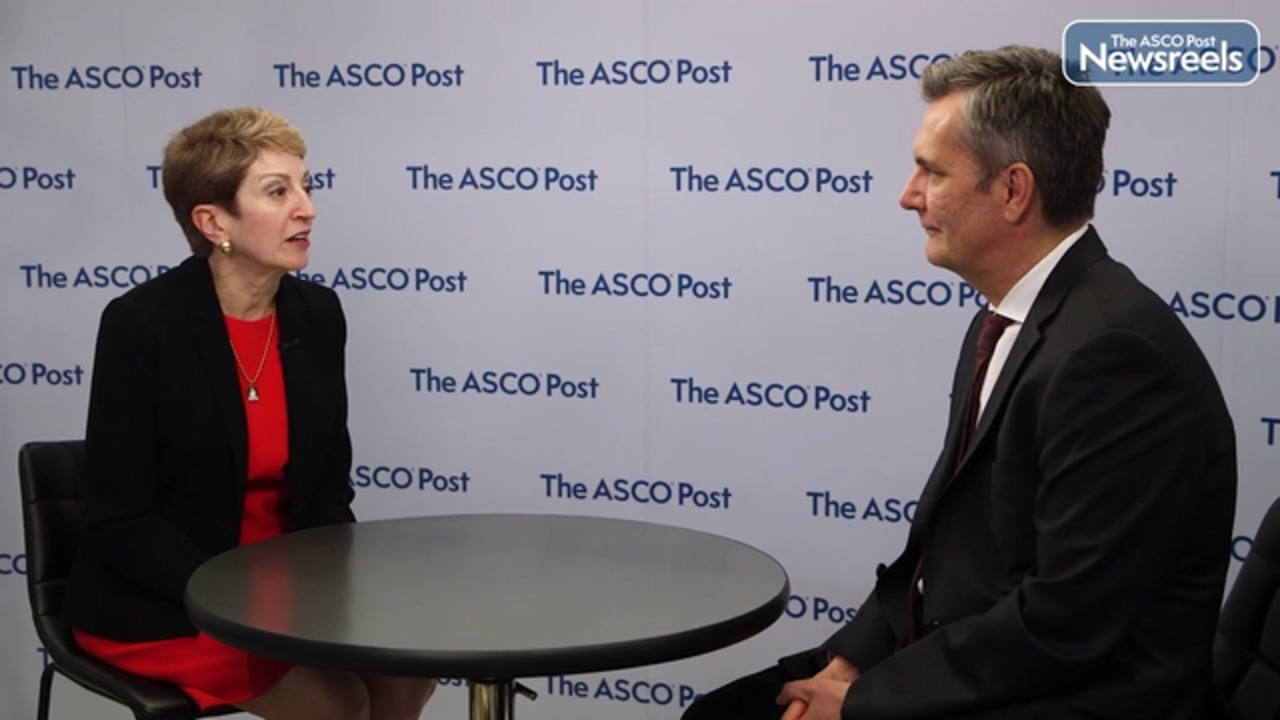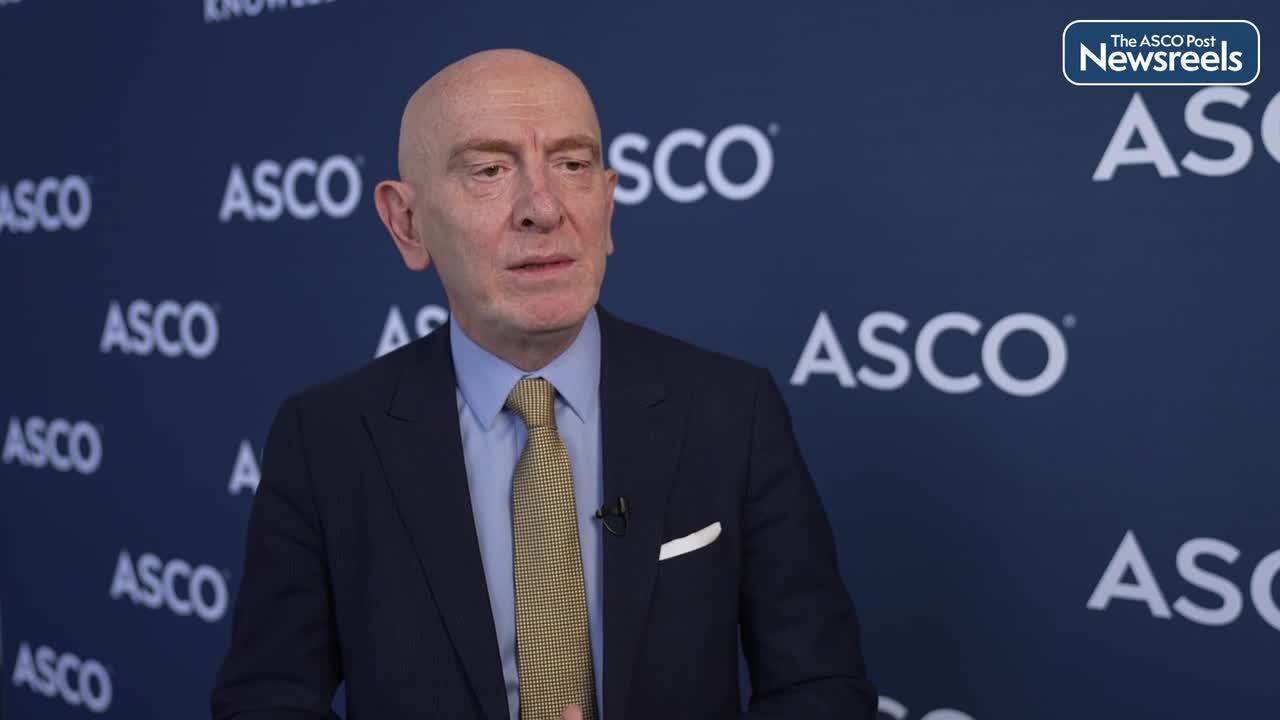Transcript
Disclaimer: This video transcript has not been proofread or edited and may contain errors.
Bobbie J. Rimel:
Dr. Moore, congratulations on your excellent late-breaking abstract. Can you tell me a little bit about the design of this study and the results?
Kathleen N. Moore:
Absolutely, and thank you so much for having me, Dr. Rimel. The MIRASOL study is a confirmatory trial, a confirmatory, randomized phase III trial, really, per the name, seeking to confirm the results of what we call the SORAYA study, which was, interestingly, a single arm phase III of the agent mirvetuximab soravtansine, which we'll call MIRV for the rest of this interview, which is an antibody-drug conjugate targeting folate receptor alpha and conjugated with a highly potent microtubule toxin DM4. SORAYA tested mirvetuximab in platinum-resistant ovarian cancer that had one to three prior lines of chemotherapy. All the patients had to have been exposed to bevacizumab and the tumors are folate receptor alpha-high, which is done, essentially, still, by an immunohistochemistry test. High means that the tumor has greater than 75% of cells with two or three plus staining. So that's a central test.
That study was designed post bevacizumab because it was an accelerated approval attempt and you have to develop in that space outside of available medicines, which would include the Aurelia label, which is single-arm chemotherapy plus bevacizumab in one to two priors. So that's why it was designed in that way. It was accelerated approval, of course, in November of 2022. Parallel with that, MIRASOL was running global randomized phase III trial, one to three priors, platinum resistant, folate receptor alpha-high, bevacizumab allowed, but not required. Because some patients, you are not eligible for bevacizumab and have platinum-resistant disease, and we need to develop agents for both populations. And so it randomized patients to mirvetuximab or investigators choice chemotherapy, weekly paclitaxel, pegylated liposomal doxorubicin or topotecan.
Primary endpoint was progression-free survival, which we met, both clinically and statistically improved progression-free survival, with a hazard ratio of 0.65. So 35% reduction in the risk of progression. Because that was positive, we could move alpha to our secondary endpoints, which are analytic. Overall response rate was the first one we looked at. Mirvetuximab improved overall response rate from 16%, which is exactly what we estimate both historically and in the statistical assumptions of MIRASOL, and basically every platinum resistant trial you say it's 15%, 16% is what we hit, versus 42% for mirvetuximab. So 2.6 times the response rate for an odds ratio over 3. So that was statistically significant.
The alpha can then roll to another analytic endpoint, which was a pre-specified look at overall survival, so an interim OS look at the time of PFS, and there were statistical boundaries set to call that positive or negative, which we met. So when we look at overall survival, we have about 13 months of follow up and we have about 68% of final OS events reporting. Hazard ratio is 0.67, so a 33% reduction in the hazard of death with use of mirvetuximab as compared to investigators choice chemotherapy.
There were no new safety signals seen with MIRASOL. We've published previously on SORAYA and FORWARD I and a lot of work, 1,000 patients treated to date with mirvetuximab. So no new signals. We still see common but low-grade ocular toxicities. And so the important thing is really to set expectations with patients that we can see, in about 42%, blurred vision, keratopathy, or dry eyes, and so we have eyedrops, mitigation strategies. Importantly, these are a hundred percent reversible and not repetitive. So it's kind of something that happens or doesn't, and then once we deal with it doesn't tend to happen in again. So it's important to patients to understand that, it's not this negligible side effect, but we mitigate it and patients are able to stay on and only 4 patients discontinued from the MIRASOL well study because of eye toxicity. I think it just shows, while we're still working on reducing rates and mitigations, it shows that our patients are able to stay on and obtain benefit.
Bobbie J. Rimel:
Excellent. When do you recommend that investigators, or now oncologists, start testing for folate receptor expression?
Kathleen N. Moore:
That's a great question. I think it will evolve more over time, but early on in the mirvetuximab program, we did a study where patients could enroll based on archival tissue, so from their primary surgery, and then we did a biopsy proximal to them starting the treatment and then an on-treatment biopsy to see if there were significant changes in the expression of folate receptor alpha temporally and spatially. It's a small study, admittedly, but we really saw fairly high concordance between time of treatment with mirvetuximab in the platinum-resistant setting versus archival. So we really think that patients can be treated, right now, at diagnosis. We're sending somatic BRCA, homologous recombination deficiency, increasingly more homologous recombination repair genes are of interest, so we're sending these big panels and it's already included in some of the commercial assays that are out there that include immunohistochemistry, importantly, those that aren't including it.
I really like to have it upfront and I like seeing it upfront because we do have clinical trials, as you know, moving mirvetuximab into the platinum-sensitive space, and so in folate receptor alpha-high, and even some smaller studies starting to look at it in frontline. So I'm testing upfront now with new patients and I'm just catching everybody, anybody that's recurrent in our practice in Oklahoma because of the access to testing that's been provided by the company so patients aren't having financial toxicity. We're just testing everybody so we know who's folate receptor alpha-high or medium, and then we can cycle in the medication as appropriate.
Bobbie J. Rimel:
Excellent. All right, last question. Nine years ago you stood in front of your very first poster with this agent. How has your view of antibody-drug conjugates changed in that time?
Kathleen N. Moore:
Yeah, it's so funny. We criticize Facebook all the time, but my Facebook memory coming to this meeting was me standing in front of the first in-human trial. It was this sort of full-circle moment for me. I loved this agent then, I was very excited by antibody-drug conjugates. We were already seeing some efficacy. So as a pretty young phase I trialist at that time, it's been nine years, I was excited. I was excited to have a new agent for our patients. I was already seeing it work. And you know, once you start to see patients benefit from an experimental agent, you start kind of laser focusing on it. And so I've been excited about it the whole time.
We've had ups and downs with the development, as you know, but this is a great day for our patients to have a new agent accessible to them, admittedly only in folate receptor alpha-high. But now the work begins to kind of prove what we all know, that it works well in medium, and make sure that that's robustly accessible to a broader population of patients at 60%. And so I'm very excited about that.
I'm excited about, there's just such a pipeline of antibody-drug conjugates with new targets and new cytotoxins that are working very well in early phase, and now even some kind of mid to later phase studies. So it's just opened up a new kind of therapeutic paradigm for our patients with differentiated safety profiles and more individualized selection of drugs.
There's still little empiricism because you're getting a chemo into the cancer cell and it has to work, we don't know that, but at least the targets there. And so we can sort of say, "This drug won't work for you because you don't have it. I'm going to do something else," versus, "This has a pretty high likelihood of helping you." In MIRASOL, the response rate's 42% by RECIST, but 80% of patients on mirvetuximab had some reduction in their tumor measurement. That's what patients, well, they want to live, they want overall survival, but that's what patients want. They want their tumors to shrink. That's what clinicians want. They want their CA 125s to come down and have that be maintained. And that's what we're seeing. So that kind of individualized approach, differentiated toxicity profiles, I think is a very patient-centric way to develop medications and move them into the right line of therapy to use.
Bobbie J. Rimel:
Congratulations on your work and thank you for all that you do.
Kathleen N. Moore:
Thank you for having me.





